Honeybee Farming Operations Management. This article explores the month-wise maintenance practices that can help beekeepers maximize profits. Beekeeping is an intricate process that requires careful attention throughout the year to ensure healthy and productive colonies. By understanding each month’s specific tasks and considerations, beekeepers can optimize their operations and achieve better financial outcomes.
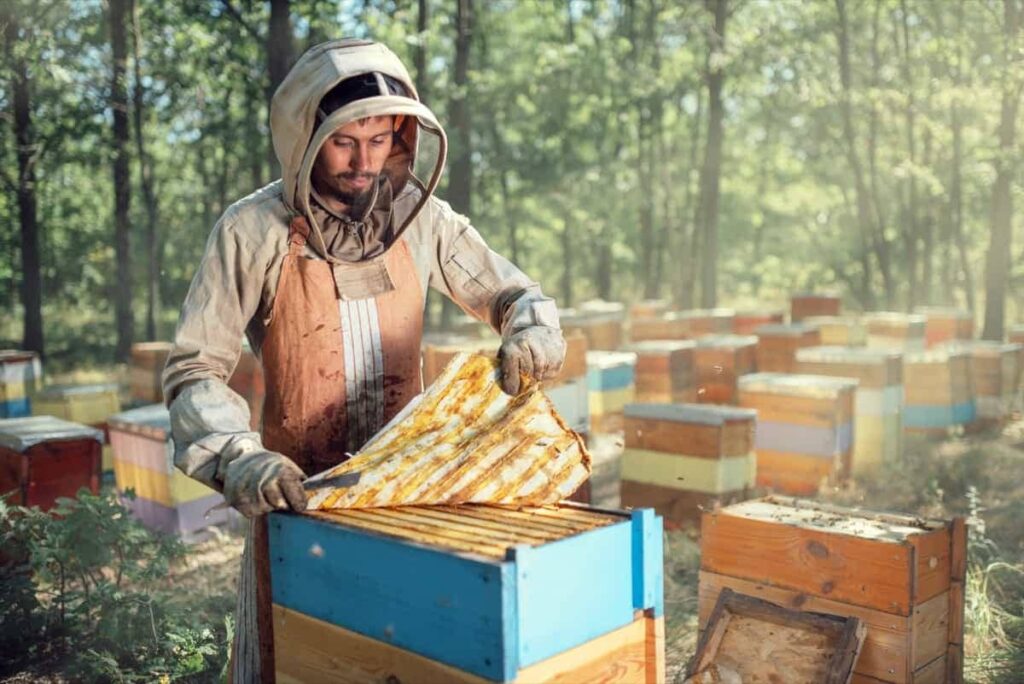
What is Honeybee Farming?
Honeybee farming, also known as apiculture, is raising and managing honeybee colonies for various purposes. Honeybees are primarily kept for their honey production but also play an important role in pollination. Beekeepers provide hives and care for the bees, ensuring their health and productivity.
Honeybees collect nectar from flowers, transforming it into honey through regurgitation and evaporation. The honey can be harvested by beekeepers and used for consumption or sold as a natural sweetener. Honeybee farming is vital for both honey production and the pollination of crops, contributing to agricultural sustainability and biodiversity.
By-products of Honeybee Farming Management for Better Profits
- Royal Jelly is a milky produced secretion by nurse bees. It contains proteins, lipids, carbohydrates, and minerals. In humans, it is believed to enhance vitality and vigor.
- Beeswax is secreted by bees and used to build combs. It varies in color depending on pollen pigments and finds applications in candle-making, creams, ointments, capsules, and other products.
- Honey, the most important product of apiculture, is the viscous fluid bees produce from flower nectar. It is a whole food rich in sugars, antibiotics, enzymes, acids, and minerals. Honey is a high-energy source used in Ayurvedic and Unani medicinal preparations.
- Propolis is a resin-like substance collected by bees from trees. It is used to seal cracks and has adhesive properties. Propolis is utilized to prepare ointments for burns, cuts, and wounds.
- Bee venom is a defensive secretion containing active chemicals. It is obtained by subjecting bees to electric shocks. Bee venom treats conditions like rheumatism, neuralgia, endoarthritis, and necrosis.
- These by-products of honeybee farming provide additional value and contribute to various industries, offering different applications in healthcare, cosmetics, and more.
What is Honeybee Beekeeper’s Calendar?
The beekeeper’s calendar is an essential tool that helps beekeepers plan and manage their honeybee farming operations throughout the year. It is closely connected to the changing seasons. It allows beekeepers to prepare their hives for temperature variations and weather shifts in advance, ensuring the health and strength of their colonies. While specific timing may vary depending on location and local weather patterns, having a clear understanding of the tasks and requirements for each month is crucial.
Conducting regular equipment checks and repairs in November, ordering packages and building new hives in December, and keeping hive entrances clear in snowy areas during January are some of the important activities during winter. As spring arrives, hive inspections, testing, and treatments for Varroa mites and adding honey supers become vital in April. It May involve removing mite treatments, adding honey supers, and monitoring for swarming. June is a busy month for hive checks, honey extraction preparations, and ensuring colony health.
In case you missed it: Honey Bee Contract Farming in India: Current Trend, Schemes, Companies, Cost, Profit, Process, Agreement, Pros, and Cons
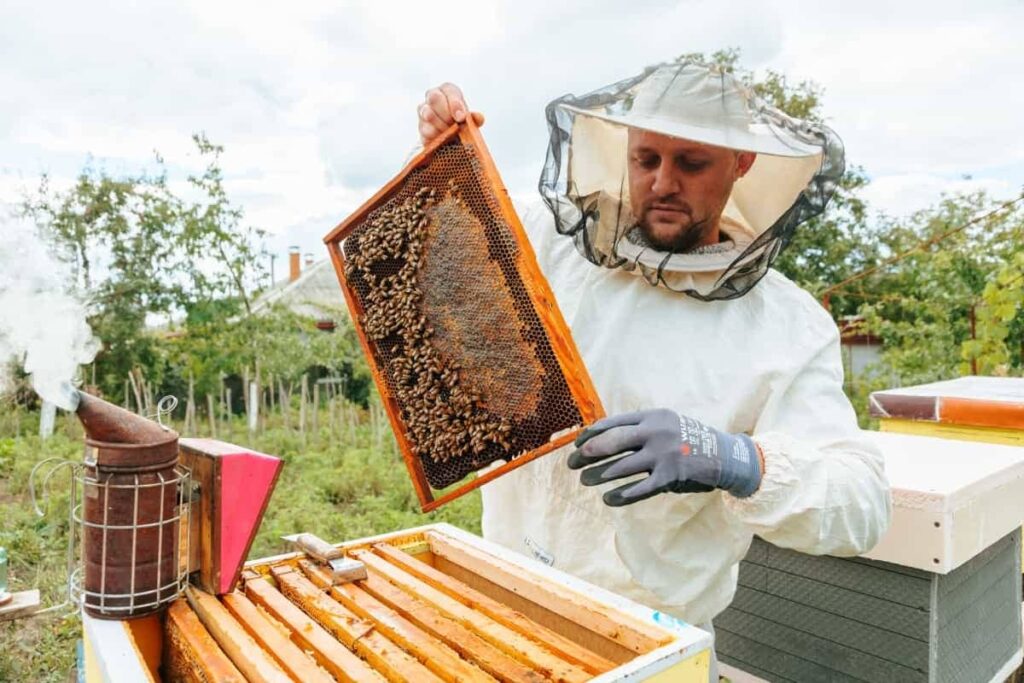
July may require adding additional supers and monitoring hive health during hot days. August and September focus on population building and preparing for winter. Harvesting honey in September, treating mites, and providing sufficient feed for the upcoming colder months are important tasks. October involves preparing colonies for winter by feeding, installing mouse guards, ensuring proper ventilation, and protecting hives from harsh weather conditions. Following the beekeeper’s calendar, beekeepers can maintain thriving honeybee colonies throughout the year.
Honeybee Farming Operations Management
Operations management in honeybee farming involves obtaining and managing production inputs, equipment, and facilities and maintaining cleanliness, training, and education. By effectively managing these operations, beekeepers can maintain healthy colonies, optimize honey production, and contribute to the overall well-being of honeybee farming.
Obtaining Production Inputs
- Beekeepers must acquire essential resources like sugar syrup, pollen substitutes, and medication for bee health management.
- Ensuring production inputs’ quality and safety is crucial to maintaining hive health and honey production.
Handling and Disposal of Production Inputs
- Proper handling and storage of production inputs, such as following instructions and avoiding contamination, is essential.
- Disposal of used or expired inputs should be done responsibly to minimize environmental impact.
Obtaining Bee Equipment
- Beekeepers must acquire necessary equipment, including hives, frames, smokers, protective clothing, and tools.
- Choosing quality equipment that is durable and suitable for beekeeping operations is important for efficient management.
Management and Maintenance of Bee Equipment, Dead bees, and Bee Products
- Regular maintenance and cleaning of beekeeping equipment are essential to prevent disease transmission and ensure optimal hive conditions.
- Proper disposal of dead bees and management of bee products, such as honey and wax, should be done hygienically and responsibly.
Personal Sanitation
- Beekeepers should maintain good personal hygiene, including washing hands, wearing clean protective clothing, and avoiding contamination between hives.
- Following personal sanitation practices helps prevent disease spread and maintains the bee colonies’ overall health.
Design of Facilities
- Designing beekeeping facilities, such as apiaries, honey extraction areas, and storage spaces, should prioritize efficiency, hygiene, and bee health.
- Adequate space, ventilation, and proper layout contribute to smooth operations and minimize disease risks.
In case you missed it: Mastering the Dragon Fruit Orchard Management: A Month-by-Month Operations Guide for Maximum Yield
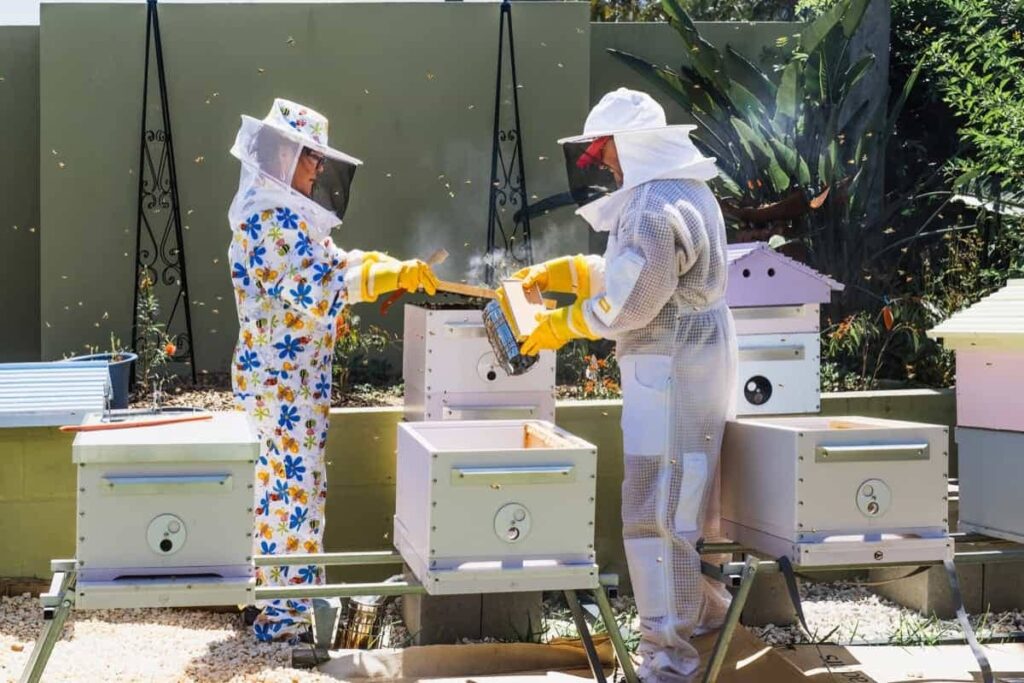
Maintenance of Premises, Buildings, Vehicles, and Other Equipment
- Maintaining beekeeping premises, buildings, vehicles, and other equipment ensures functionality and longevity.
- This includes repairing structures, servicing vehicles, and checking equipment for wear and tear.
Control of Weeds and Nuisance Pests
- Managing weeds and nuisance pests in and around the apiary is important to create a favorable environment for bees.
- Practices such as mowing grass, removing weeds, and controlling pests like ants and wasps contribute to the well-being of the colonies.
Training and Education
- Beekeepers should continuously seek training and education to stay informed about best practices, disease prevention, and industry developments.
- Attending workshops, courses, and conferences helps enhance beekeeping skills and promotes sustainable management practices.
Month-wise Honeybee Farming Operations Management
January Month Maintenance and Operations for Better Profits in Honeybee Farming
Hive Inspection and Maintenance
- Performing thorough inspections of hive structures, frames, and equipment.
- Checking for signs of damage, mold, or pests that could affect colony health.
- Cleaning and repairing any issues found during the inspection.
Assessing Honey Stores
- Evaluating the amount of honey stored by the colony.
- Ensuring the bees have enough foliage to sustain them through the winter.
- Supplementing with sugar syrup or fondant if necessary to prevent starvation.
Preparing for Early Spring Buildup
- Monitoring the queen’s egg-laying activity.
- Providing adequate space for the expanding brood nest.
- Planning for potential hive splits or expansion to prevent overcrowding.
February Month Maintenance and Operations for Better Profits in Honeybee Farming
Monitoring Brood Production
- Tracking the development of brood cells and larvae.
- Assessing the queen’s performance in terms of egg-laying rate and brood health.
- Identifying and addressing any issues that may hinder brood production.
Feeding Colonies if Necessary
- Offering supplementary food, such as sugar syrup or pollen patties, if natural forage is limited.
- Ensuring the bees have sufficient nutrition for brood rearing and colony growth.
- Monitoring feed consumption to gauge colony health and food availability.
Preparing for Orchard Pollination
- Coordinating with orchard owners for pollination contracts like almonds, apples, Berries, etc.
- Scheduling hive transportation and placement in the orchards.
- Ensuring the colonies are strong and healthy to maximize pollination services.
March Month Maintenance and Operations for Better Profits in Honeybee Farming
Expanding Hive Space
- Adding extra boxes or supers to accommodate the growing bee population.
- Providing adequate storage for nectar and honey production.
- Ensuring proper ventilation to prevent hive overheating.
Splitting Strong Colonies
- Dividing a healthy colony into two or more hives.
- Creating new queen cells or introducing new queens to the split colonies.
- Expanding the apiary and increasing the number of bee colonies.
Preparing for Fruit Tree Pollination
- Contacting orchard owners to arrange pollination contracts.
- Coordinating hive placement in orchards based on the bloom schedule.
- Ensuring the colonies are in optimal condition for effective pollination.
April Month Maintenance and Operations for Better Profits in Honeybee Farming
Swarm Prevention Measures
- Performing regular hive inspections to detect swarm preparations.
- Removing queen cells or initiating artificial swarming techniques.
- Providing sufficient space, ventilation, and swarm lures to deter swarming behavior.
Queen Rearing and Replacement
- Identifying underperforming queens or aging queens for replacement.
- Introducing new queen cells or purchasing queen bees from reputable breeders.
- Ensuring successful queen acceptance and colony continuity.
Ensuring Sufficient Forage Availability
- Monitoring local nectar flow and pollen sources.
- Encouraging nearby flowering plants or cultivating bee-friendly gardens.
- Supplementing natural forage with sugar syrup if necessary.
May Month Maintenance and Operations for Better Profits in Honeybee Farming
Monitoring Honey Production
- Assessing honey stores and surplus production.
- Adding honey supers to accommodate increasing nectar flow.
- Balancing honey extraction with the colony’s needs for winter reserves.
Disease And Pest Management
- Conduct thorough inspections for signs of diseases or parasites.
- Treating colonies for common pests like Varroa mites and controlling diseases.
- Implementing integrated pest management strategies for sustainable bee health.
Preparing for Honey Extraction
- Collecting necessary extraction equipment and supplies.
- Ensuring proper sanitation of honey harvesting equipment.
- Timing the extraction process to maintain honey quality and freshness.
In case you missed it: Optimizing Date Palm Orchard Management: A Month-by-Month Operations Guide for Maximum Yield
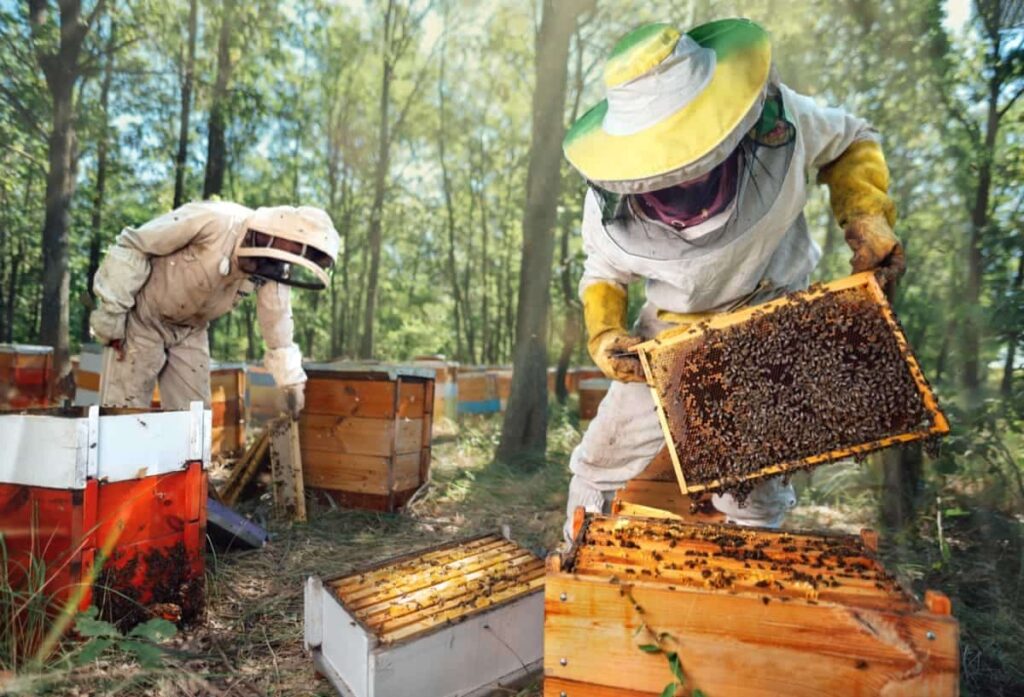
June Month Maintenance and Operations for Better Profits in Honeybee Farming
Harvesting Honey
- Removing honey supers and extracting honey from frames.
- Processing and storing honey in appropriate containers.
- Labeling and preparing honey for sale or personal use.
Evaluating Colony Health
- Assessing the overall condition of the colonies.
- Checking for signs of disease, pests, or queen performance issues.
- Addressing any health concerns promptly to maintain strong colonies.
Preparing for Summer Dearth
- Monitoring nectar availability during the summer season.
- Providing supplemental feeding if nectar flow is limited.
- Ensuring colonies have access to water sources for hydration.
July Month Maintenance and Operations for Better Profits in Honeybee Farming
Providing Water Sources for Bees
- Setting up water stations or providing access to natural water sources.
- Ensuring a constant clean water supply prevents bees from seeking other potentially harmful sources.
Monitoring Mite Levels
- Regular mite checks using sticky boards or other monitoring methods.
- Treating colonies if mite levels exceed recommended thresholds.
- Implementing integrated pest management techniques for mite control.
Managing Hive Ventilation
- Ensuring proper airflow to regulate temperature and humidity.
- Installing screened bottom boards or adding ventilation holes.
- Preventing hive overheating during hot summer months.
August Month Maintenance and Operations for Better Profits in Honeybee Farming
Assessing Hive Strength
- Evaluating the colonies’ population, brood pattern, and overall vitality.
- Identifying weak colonies that may need reinforcement or merging with stronger ones.
- Making decisions on colony management for the upcoming fall season.
Preparing for Fall Nectar Flow
- Monitoring local flora for fall flowering plants.
- Maintaining sufficient hive space for honey storage during the fall flow.
- Ensuring colonies are healthy and strong to capitalize on nectar opportunities.
Harvesting and Processing Honey Products
- Extracting and processing any remaining honey from supers.
- Filtering and bottling honey for sale or personal use.
- Managing inventory and storage of honey products.
September Month Maintenance and Operations for Better Profits in Honeybee Farming
Preparing Colonies for Winter
- Assessing colony strength and food stores for winter survival.
- Providing insulation or wrapping hives for cold weather protection.
- Implementing winter feeding strategies if necessary.
Varroa Mite Treatment
- Conducting mite counts and choosing appropriate treatment methods.
- Administering mite treatments following recommended guidelines.
- Monitoring treatment efficacy and adjusting if needed.
In case you missed it: Optimizing Cashew Orchard Management: A Month-by-Month Operation Guide for Maximum Yield
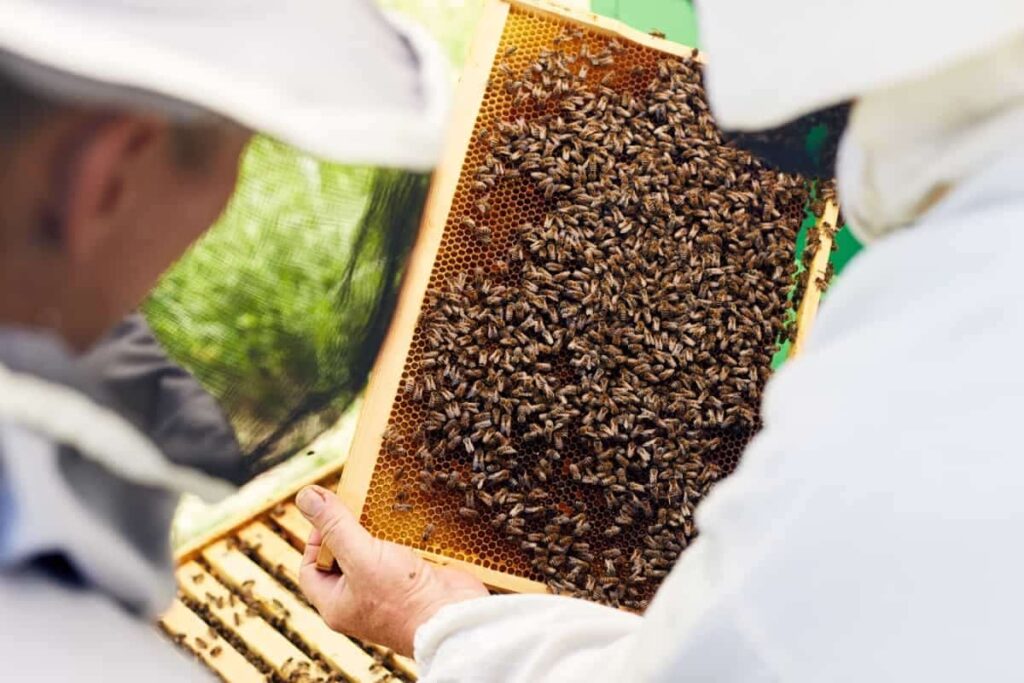
Storage and Maintenance of Equipment
- Cleaning and storing extraction equipment, supers, and frames.
- Inspecting and repairing any damaged or worn-out equipment.
- Organizing beekeeping tools and supplies for easy access in the following season.
October Month Maintenance and Operations for Better Profits in Honeybee Farming
Assessing Hive Health And Population
- Conducting final inspections before winter to ensure colony strength.
- Identifying and addressing any issues or weaknesses.
- Verifying adequate winter food stores for the colony.
Monitoring Food Stores for Winter
- Checking honey reserves and supplementing if necessary.
- Assessing pollen stores to ensure sufficient protein for brood rearing.
- Preparing emergency feed options in case of unexpected food shortages.
Implementing Winterizing Techniques
- Insulating hives to protect against freezing temperatures.
- Reducing hive entrances to prevent drafts and heat loss.
- Preparing windbreaks or relocating hives to sheltered areas.
November Month Maintenance and Operations for Better Profits in Honeybee Farming
Insulating Hives for Cold Weather
- Adding additional insulation materials to the hive.
- Wrapping hives with insulating materials like foam or tar paper.
- Creating windbreaks or placing hives in protected locations.
Feeding Bees, if necessary
- Monitoring food stores and providing supplemental feeding.
- Using fondant or sugar cakes as emergency winter food sources.
- Checking feed consumption to ensure bees have sufficient nourishment.
Conducting Final Hive Inspections
- Assessing the overall health and vitality of the colonies.
- Addressing any health issues or queen performance concerns.
- Making necessary adjustments or interventions for colony survival.
December Month Maintenance and Operations for Better Profits in Honeybee Farming
- Monitoring and protecting hives from extreme weather conditions
- Checking hive entrances for snow blockage or ice formation.
- Clearing snow around hives and ensuring proper ventilation.
- Protecting hives from strong winds or severe weather events.
Planning for the Upcoming Year
- Reviewing beekeeping records and evaluating the previous year’s performance.
- Setting goals and strategies for the upcoming beekeeping season.
- Ordering necessary equipment, supplies, or new colonies in advance.
Educating Oneself Through Workshops or Courses
- Participating in beekeeping workshops or online courses for ongoing learning.
- Staying updated with the latest research and best practices in beekeeping.
- Connecting with fellow beekeepers for knowledge sharing and support.
In case you missed it: How to Grow and Care for Snapdragon Flowers: A Step-By-Step Comprehensive Guide
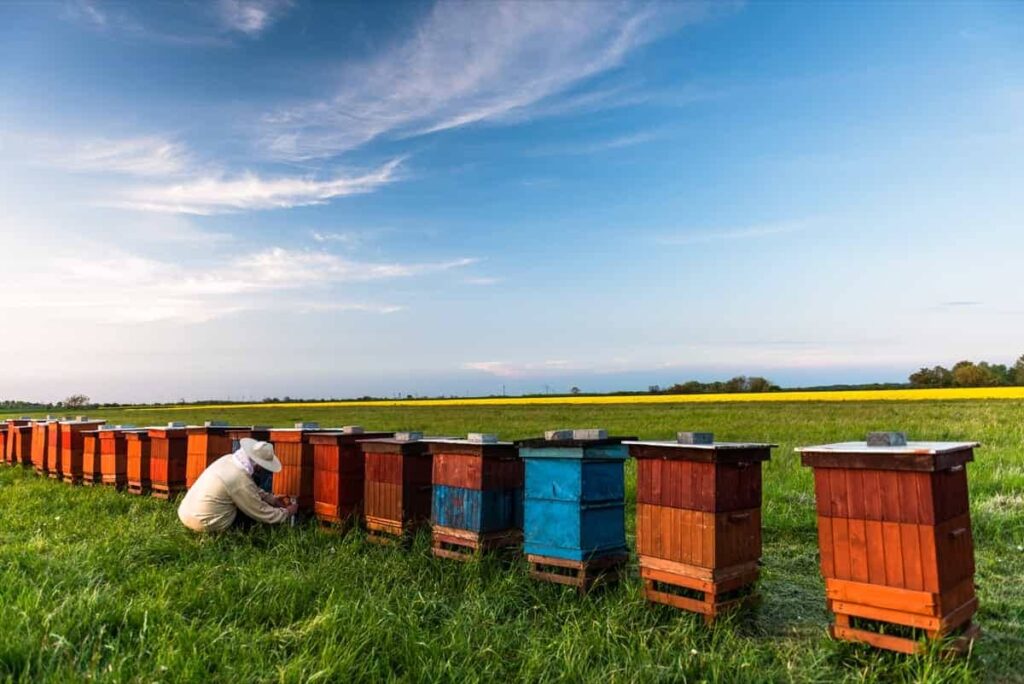
Conclusion
Beekeepers can maximize profits by following a month-wise maintenance plan in honeybee farming operations. Consistent hive maintenance, disease prevention, strong colony management, and continuous learning are key factors for achieving better profits in this industry.
- Management Pests and Diseases in Your Cotton Field
- Sheep Farming Business Plan for Beginners
- Aquaponic Farming at Home: A Step-By-Step Guide
- Profitable Village Farming Business Ideas in 2024
- High-Yield Aquaculture: Fast-Growing Fish for Farming
- Effective Fish Pond Construction Techniques for Beginners
- Irrigation and Water Management in Pineapple Farming
- Blossom to Harvest: Mastering Flowering and Pollination in Papaya Farming
- Pig Fattening Essentials: From Selection to Sale for Beginners
- Raising Wagyu Cattle: A Complete Guide for Premium Beef Production
- Soil Types and Their Water Holding Capacity
- Optimizing Irrigation Schedules for Coconut Groves for Enhanced Yield
- Espresso Your Garden: Coffee Grounds for Healthier Acid-Loving Plants
- The Best Soil Mix for Snake Plants: How to Mix Your Own Snake Plant Soil
- Green Thumb Success: Expert Tips for Cultivating Greenhouse Beans All Year Round
- Bloom All Year Round: The Ultimate Guide to Indoor Hyacinth Care
- Eco-Friendly Gardening: How to Make Liquid Fertilizer from Kitchen Waste
- Ultimate Guide to Grow Anise in Pots: Explore Seed Propagation to Harvesting
- Guide to Raising Chester White Pigs: Discover Breed Facts to Growth Management
- Mastering the Elegance: The Ultimate Guide to Weeping Cherry Tree Care, Planting, and Maintenance
- Ultimate Guide to Planting Garlic in Grow Bags: Growing Strategies for Beginners
- How to Fix Spider Plant Leaf-Related Problems: Natural and Organic Remedies
- 10 Reasons Why Your Tulsi Plant is Shedding Leaves: Home Remedies and Solutions
- Optimizing Growth and Yield: The Advantages of Palm Bunch Ash Fertilizer
- Utilizing Neem Oil Extract as a Natural Pesticide for Hydrangea
- From Soil to Harvest: Various Ways in Which Farmers Can Use AI Tools
- Steps to Encourage and Induce Citrus Flowers: A Comprehensive Guide
- How to Fix Snake Plant Leaf-Related Issues: Natural and Organic Remedies
- Transform Your Garden into a Fragrant Oasis with Raat Ki Rani (Night Blooming Jasmine)
- Discover the Ideal Chicken Breeds for Philippine Farms
- How to Create a Poultry Egg Farm Business Plan for Profits
- Grow Lemon Cucumbers Like a Pro: Insider Techniques for Bountiful Yields
- Ultimate Guide to Caring for Your Pink Princess Philodendron: Tips for Thriving Variegation
- Areca Nut Profit Per Acre: Calculating Yield and Cost of Cultivation
- How Kaveri Chicken is Becoming a More Profitable Breed in Indian Backyards
- Transform Your Barn: 9 Steps to Convert a Horse Stall into a Chicken Coop
